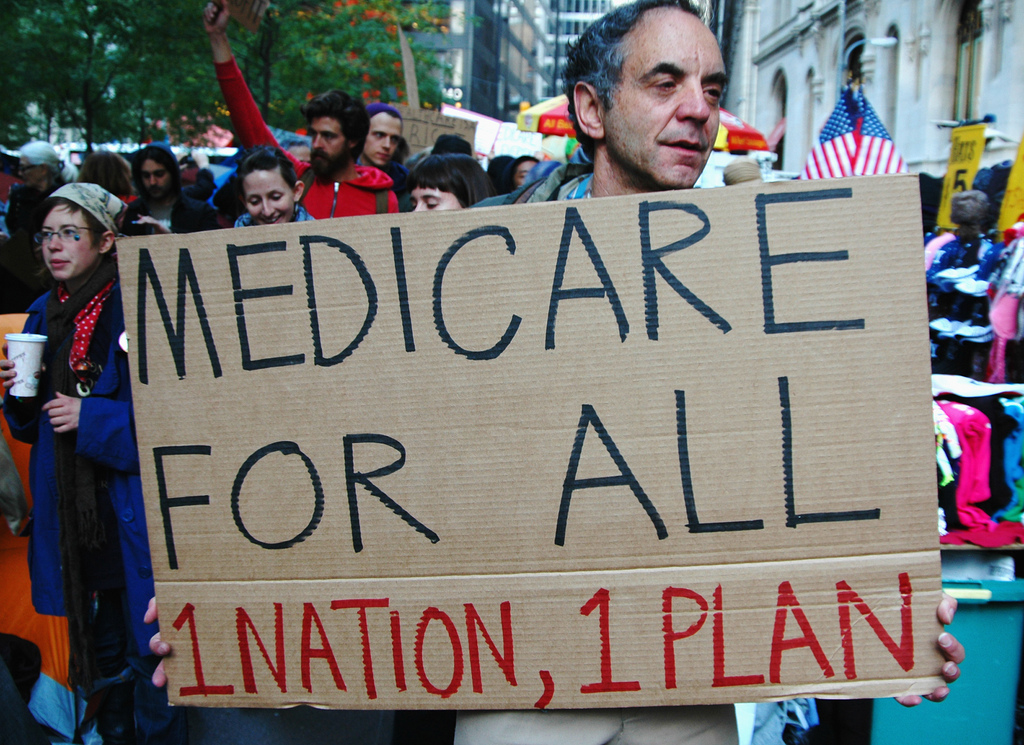Here’s How ‘Medicare for All’ Would Save Trillions of Dollars
A Koch brothers-funded study that produced scare headlines about the cost of a single-payer system is flawed in serious ways. What we cannot afford is the system we have now. Associated Press
Associated Press
A recent report by the Koch Brothers-funded Mercatus Center at George Mason University found that moving to a National Improved Medicare for All single payer healthcare system would increase federal spending. They analyzed Senator Sanders’ Medicare for All Act and estimated it would increase annual federal spending by $32 trillion over ten years. Don’t let their attempt to weaken the strong support for single payer healthcare in the US fool you. Even though their report underestimates the savings, they admit that single payer would lower the total cost of health care.
Of course, a National Improved Medicare for All (NIMA) system would increase federal spending, but not by as much as they claim. NIMA would create a national health insurance, like most other wealthy countries have, funded only through taxes. This would replace our current complicated, privatized healthcare system, funded through a mix of premiums, out-of-pocket costs and taxes, which is the most expensive in the world. Countries that treat health care as a public good invest in a universal system because they know it improves the health of their people and is the most efficient.
The United States currently spends twice as much as the average wealthy nation, over $10,000 per person each year. Unlike other wealthy nations though, the US leaves tens of millions of people without coverage and tens of millions more with coverage but still unable to afford care. The US consistently ranks low in comparison to other countries on health outcomes. Life expectancy is declining in the US, now for two years in a row, the first time this has happened in over 50 years. Death rates for infants and mothers in the US are many times higher than in other wealthy countries.
A single payer healthcare system like NIMA would decrease administrative costs and the prices of goods, such as pharmaceuticals, and services dramatically. Rather than having hundreds of different healthcare plans, each with different rules, there is one comprehensive plan with one set of rules. It would relieve families, employers, health professionals and hospitals of the burden of navigating the current complex system. Everyone is in the system for life. If a person needs health care, they see a health professional of their choice, the health professional cares for the patient and submits a bill to the system, or they are paid a salary, and that’s it. Simple. Just as it is in most other industrialized countries.
The Mercatus Center study is flawed in serious ways. First, it analyzes the Senate bill, which was first introduced last September and has significant weaknesses. It would be better to examine the House bill, HR 676, which has been introduced every session since 2003 and is based on the Physicians’ Working Group Proposal by Physicians for a National Health Program, the leading experts on single payer health policy in the US (here is the updated proposal). Second, it grossly underestimates the savings of a single payer system and makes unrealistic assumptions about utilization of services.
There have been many studies over the past few decades on how much money a single payer system would save in the United States. In 1991, the General Accounting Office found “If the US were to shift to a system of universal coverage and a single payer, as in Canada, the savings in administrative costs [10 percent of health spending] would be more than enough to offset the expense of universal coverage.” Since that time, administrative costs have ballooned to one-third of our healthcare spending and the prices of pharmaceuticals have soared, so the savings would be greater.
In 1991 and 1993, multiple analyses by the Congressional Budget Office found that covering everyone under a single payer system might increase spending at the beginning, but it would be offset quickly by the savings. Since then, studies by non-governmental institutions, including one by Ken Thorpe who, since his alliance with Hillary Clinton, now claims the opposite, have all shown that compared to other reforms, NIMA is superior in savings and in the number of people and benefits that are covered.
It is important to distinguish between total healthcare spending and federal spending, the part the US government spends. Buried within the Mercatus Center study is a fact that the corporate media has missed. Although they estimate that federal spending would increase, because all health spending would become federal, they calculate that overall health spending would decrease by more than $2 trillion over ten years.
Single payer systems save money. The only system we can’t afford to maintain is the current one. Private health insurers are insatiable. The government subsidizes them by hundreds of billions of dollars a year, and still they raise premiums and out-of-pocket costs and ask for more. Pharmaceutical companies are increasing their prices by as much as they can get away with. A single payer system is the best way to put private insurers where they belong, on the margins of our healthcare system, and to control the pharmaceutical industry.
So, when you hear someone saying that NIMA would increase federal spending, tell them of course it does, that’s the point. Instead of paying premiums, deductibles and co-pays to a private insurer, we all contribute into a federal system that is there when we need it. But if they try to scare you with large numbers, tell them that single payer systems prove time and again they are the least expensive. If we want to talk about scary numbers, let’s look at how much the US spends on the military and have a conversation about priorities – ending lives or saving them.
Your support matters…Independent journalism is under threat and overshadowed by heavily funded mainstream media.
You can help level the playing field. Become a member.
Your tax-deductible contribution keeps us digging beneath the headlines to give you thought-provoking, investigative reporting and analysis that unearths what's really happening- without compromise.
Give today to support our courageous, independent journalists.








You need to be a supporter to comment.
There are currently no responses to this article.
Be the first to respond.